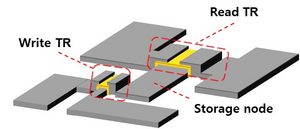Researchers at POSTECH have developed a high-performance AI semiconductor device using indium gallium zinc oxide (IGZO), an oxide semiconductor widely used in OLED displays. The new synapse device is composed of two transistors interconnected through a storage node, allowing for precise control of the charging and discharging speed. The researchers utilized materials already in mass production, overcoming the limitations of conventional AI semiconductor technologies. This successful development and application of new AI semiconductor technology show great potential to improve the efficiency and accuracy of AI. The research team confirmed the possibility of utilizing the ultra-thin film insulators inside the transistors to control the current, making them suitable for large-scale AI. The study was supported by the Next-Generation Intelligent Semiconductor Technology Development Program through the National Research Foundation, funded by the Ministry of Science and ICT of Korea.
AI “Brain” made from Core Materials for OLED TVs
A team of researchers from POSTECH has developed a high-performance AI semiconductor device using indium gallium zinc oxide (IGZO) – a compound widely used in OLED displays. The device is efficient in terms of performance and power consumption, making it an ideal material for AI computations.
The traditional digital computer system’s von Neumann architecture limits efficient AI computations because it separates the storage and computation of information, resulting in increased power consumption and significant delays in AI computations. The new device developed by the POSTECH research team addresses this challenge.
Efficient AI operations require computations to occur within the memory responsible for storing information. However, previous AI semiconductor technologies were limited in meeting all the requirements, such as linear and symmetric programming and uniformity, to improve AI accuracy.
The POSTECH team found IGZO to be the key material for AI computations that could be mass-produced and provide uniformity, durability, and computing accuracy. This compound comprises four atoms in a fixed ratio of indium, gallium, zinc, and oxygen and has excellent electron mobility and leakage current properties, which have made it a backplane of the OLED display.
The new device is a high-performance AI semiconductor that uses IGZO as a core material. It has been proven to be excellent in terms of performance and power efficiency, making it ideal for AI computations.
This breakthrough is significant for the AI industry because the AI language model relies on deep learning, which requires extensive training to minimize errors, resulting in frequent data transfers between memory and processors. The research team’s development of a semiconductor device suitable for AI applications addresses the challenge of the traditional digital computer system’s von Neumann architecture, which limits efficient AI computations.
Overall, the development of this high-performance AI semiconductor device using IGZO by the POSTECH research team is a significant breakthrough for the AI industry, paving the way for more efficient and powerful AI computations.
Novel Synapse Device Developed with Mass-Produced Materials
Researchers from POSTECH have developed a new synapse device composed of two transistors interconnected through a storage node using indium gallium zinc oxide (IGZO) materials. The researchers utilized materials already in mass production to overcome the limitations of conventional AI semiconductor technologies that focused solely on material development.
The researchers were able to achieve linear and symmetrical programming characteristics through a new structure using two transistors as one synaptic device. The precise control of the storage node’s charging and discharging speed allowed the AI semiconductor to meet the diverse performance metrics required for high-level performance.
Furthermore, the researchers confirmed the possibility of utilizing the ultra-thin film insulators inside the transistors to control the current, making them suitable for large-scale AI. The new synaptic device was used to train and classify handwritten data, achieving a high accuracy of over 98%.
According to Professor Chung, this successful development and application of the new AI semiconductor technology show great potential to improve the efficiency and accuracy of AI. This study was supported by the Next-Generation Intelligent Semiconductor Technology Development Program through the National Research Foundation, funded by the Ministry of Science and ICT of Korea. It was published on the inside back cover of Advanced Electronic Materials last week.
Overall, the use of mass-produced materials in the development of this new synapse device by the POSTECH research team shows significant potential for improving the efficiency and accuracy of AI in the future.
Don’t miss interesting posts on Famousbio










